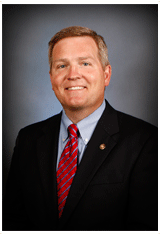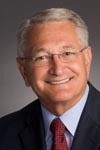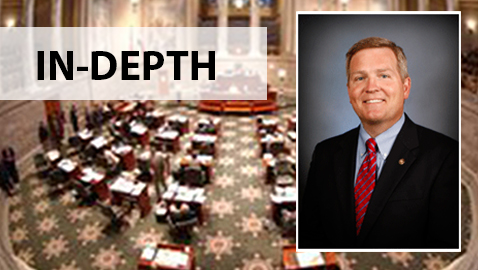By Ashley Jost
JEFFERSON CITY, Mo. — With education being a priority of leadership in both chambers this session, the progress of the main vehicle for funding higher education — Senate Bill 437 — is becoming a top focus as the Senate prepares to bring it to the floor for debate.
The bill passed the Senate Education Committee two weeks ago, and its sponsor, Sen. David Pearce, R-Warrensburg, said based on his conversation with leadership, it could hit the floor as early as Tuesday.

The saga of the current funding formula creation process began when Gov. Jay Nixon signed House Bill 1731 into law last May. The law charged the Joint Committee on Education to create a performance-based funding formula for state higher education institutions by 2015.
In addition to being the bill sponsor, Pearce chairs the Joint Committee as well as the Senate Education Committee. He said the process has been long and involved the voices and work of many vested parties, but that he’s proud of the progress that was made.
The Joint Committee’s work created an opportunity, he said, for the 13 public four-year schools and 12 community colleges, plus their associations, to speak on behalf of their interests in creating groundwork for the performance-based funding model.
Prior to whatever the end result of the current funding legislation may be, much of the higher education funding decisions were based off of general percentage increases and decreases, which many thought to be unfair because the vast differences between the institutions. Some of the concern stemmed from funding being based on enrollment, which smaller universities were unhappy with.
As performance-based funding models are being worked on in 30 other states across the country, Pearce said the same implementation needed to come to Missouri, no matter how hard the task to create it may be.
The biggest challenge, Pearce said, has been finding the fit for schools that range from research one institutions, to highly selective, to open enrollment: a task that he’s confident is possible to achieve.
“Performance funding for higher education is tough,” he said. ‘For the most part, universities and their presidents just look at their own institutions. So you have to ask how you practice statewide policy that’s fair to all and really puts in some expectations and standards. It’s not easy, but we have to be fair to everybody. We’re trying to say that as a state, there are certain things we like, and that we have expectations we want [universities] to excel in, and [they] will get rewarded for that.”
Pearce said his bill encompasses 10 percent of existing funding, along with all new funding — differing from the governor’s initial idea of only using new funds, but still something Pearce said he thinks the governor is on board with. He said the four-year public schools argued for half of new funding, but Pearce and the governor both wanted the entirety.
“Schools wanted half because it’s less funding in jeopardy and less funding based on performance,” Pearce said. “To me, it’s got to have some meaning. It’s got to stand for something. By adding ten percent of your exiting funding, we’re saying that it’s important.”
A motivator for implementing this legislation is a common goal by the committee and the governor to increase Missouri’s percentage of people who have some form of post-secondary education from its current 39 percent to 60 percent by 2025.
Pearce said he thinks the importance of performance funding transcends party lines, as shown by the support and relationship with the governor’s office.
“There are people with questions or concerns, but it’s not one party or the other, it’s who they’re representing,” Pearce added.
Four-year institutions
Pearce said a “tall order” was placed on universities in preparation for the Joint Committee’s report, as well as SB437.

Principal among the four-year institutions is the broad association: Council on Public Higher Education. Pearce said COPHE was tasked with creating amendments or changes they “could live with,” in order for him to get an idea of what the council that manages the 13 different institution’s perspectives would like to see.
COPHE Executive Director Paul Wagner said throughout the entire process, the organization has tried to provide as much input as possible to legislators on and off of the Joint Committee.
“This is a naturally complicated issue,” Wagner said. “Anytime you’re talking about a higher education process that involved $800 to $900 million, it’s going to be complicated.”
Wagner said his job has been to work with university presidents and their staff as a team to express concerns. He said during the one public hearing for SB437, he spoke on behalf of COPHE, testifying for informational purposes as the four-year schools have “several fundamental concerns with the bill.”
“One of our main concerns at that time was that the main incentive in this formula is simply to increase enrollment, still,” Wagner said. “And while that should be part of any finance model, it can’t be the overwhelming policy.”
Wagner said of the categories of expenses the bill uses to show how much money each institution receives from the state, the largest — accounting for about 70 percent of funding — is the instruction category. He explained that his concern is that the instruction category counts how many credit hours students earn.
“So if an institution wants to do well under the formula, it needs to increase the number of credit hours it’s serving,” he said. “And the best way to do that is to increase enrollment.”
Troy Paino, Truman State University President, said in an email that his concern is the proposed formula could “disproportionately [incentivize] enrollment growth” over performance.
“If we do not incentivize higher expectations, the quality of learning that occurs in the pursuit of those degrees and whether or not our students are achieving the competencies that will make them successful in service to our democracy and economy, people will increasingly question the value of a college degree,” he added.
Another issue Wagner said COPHE has is the broad concern that all of the Missouri institutions are generally underfunded. He said he does not think money should be shifted from one institution to another, and said the bill has mechanisms he thinks would allow for that to happen.
An example of a concerning mechanism for COPHE, Wagner said, is the bill’s stop-loss provision, which he said means if the formula is run for each school and the result of the formula says the school should have less money than they are receiving, they could be cut by two percent.
“We think that should be zero percent,” he said. “You can’t have overfunded institutions. I think it’s a fundamental principle that institutions can’t lose money through this process, and this bill doesn’t provide that assurance.”
Wagner said overall, he thinks it is possible to have a cohesive higher education finance policy, and COPHE plans to continue the conversation with legislators as the bill is further discussed.
Community colleges
With four-year institutions representing about half of the interests involved in the funding formula, the other half, the community colleges, have and continue to weigh in on the subject.
Pearce said the final formula created by the Joint Committee leaned more toward enrollment-based funding for community colleges — a major change between the committee’s final report and the outcome of SB437.
Another top concern of the community colleges was the amount of local property tax that the legislators initially talked about deducting from their total funding.
Zora Mulligan, executive director of the Missouri Community Colleges Association, said “the initial recommendation to deduct half of the local tax support” for community colleges target funding was a significant issue for the association and its members.

“We felt that for several reasons, that just wasn’t good public policy,” she said. “It wasn’t fair to our citizens and it didn’t make sense from a funding perspective, so we worked hard on communicating the reasons that was punitive to local institutions and we were grateful with the Senate Education Committee voted to remove that.”
Prior to the committee meeting where they held the final vote, Pearce told the Missouri Times he had some concerns about the community college portion of the model regarding the personal property tax, saying that if the legislature takes all of their property tax, the community colleges will be receiving “a huge amount of funding at the expense of the four-years.”
“That’s not the design of [SB]437,” he added. “It’s not to determine how much is given, it’s to determined how much two-years and four-years get. Then once that dollar amount is determined, how it gets distributed.”
Pearce said not deducting half of the local property tax could as much as double the amount of funding for community colleges, which he said he would love to do if it was not at the expense of other institutions.
Kent Kay, vice chancellor for Finance and Administration for St. Louis Community College, told the Missouri Times a few weeks ago that he thinks local taxes should not be subtracted, as those taxes are designed for reduction in tuition to keep colleges affordable and boost community support.
Mulligan, whose association speaks for all 12 community colleges throughout the state, said while the association has been actively focused on the property tax issue during the process so far, they have an ongoing appreciation for the effort of the legislature to steer away from the way higher education has been funded during the past.
“What this formula does is create a framework that helps build the foundation for the argument for increasing funding to all higher education institutions,” she said.
Mulligan said the association and its members are happy with the way the bill is and will continue to watch it closely as it moves forward.
Looking ahead

Sen. Pearce said he has made a point of keeping in touch with Rep. Mike Thomson, R-Maryville, the chair of the House Higher Education Committee who also sat on the Joint Committee, as he will likely be the bill handler if it moves to the House.
Thomson said he has been impressed by the way all of the interests involved have worked together on the issue, as it’s something they’ve rarely had to do before. However, Thomson said he couldn’t say whether he’s sure SB437 will move through as is.
“The community colleges are happy now [because of the property tax issue], but the four years aren’t going to be happy about this at all,” he said. “However you do it, someone is going to be unhappy. Whether or not it moves through as is, I don’t know, but it’s going to need some discussion and people are going to need to come to the table to make some agreements.”
Thomson said he thinks the issue is “more than possible” to come to a conclusion. He said with the amount of research put in by the Joint Committee and Pearce, the work is there, the issue is now finalizing agreements.
“My philosophy is, if you can get all of the stakeholders involved and get their input, it’s sometimes better than just getting something out there just to pass it,” he said. “We have to have performance built into this formula. That’s the trend of the future. If we’re going to continue to improve higher education for the state, they need to be accountable.”
As it makes its way to the floor, Pearce said his main hope is that there will not be too many changes requested by other legislators.
“You can’t change it too much or you lose the integrity of the bill,” he said. “Fundamentally, I want a policy that’s fair to all of our institutions, and I want to look at a long-term funding solution. I don’t want to see an exemption for this university and that university. After a while, when you do that, you don’t have a formula. You have a patchwork of exceptions that won’t do anyone any good.”
Pearce said he thinks it is plausible for the bill to pass this year and receive the governor’s approval. Until then, the debate continues.
Be sure to check out the work of the Joint Committee online, as well as the fiscal note of SB437, which includes commentary from some of the institutions, organizations and elected officials.
Author’s disclaimer: Ashley Jost is a student at Truman State University. At least five of the 13 four-year universities were contacted, Truman State responded.
To contact Ashley Jost, email ashley@themissouritimes.com, or via Twitter at @ajost.
Ashley Jost is no longer with The Missouri Times. She worked as the executive editor for several months, and a reporter before that.




